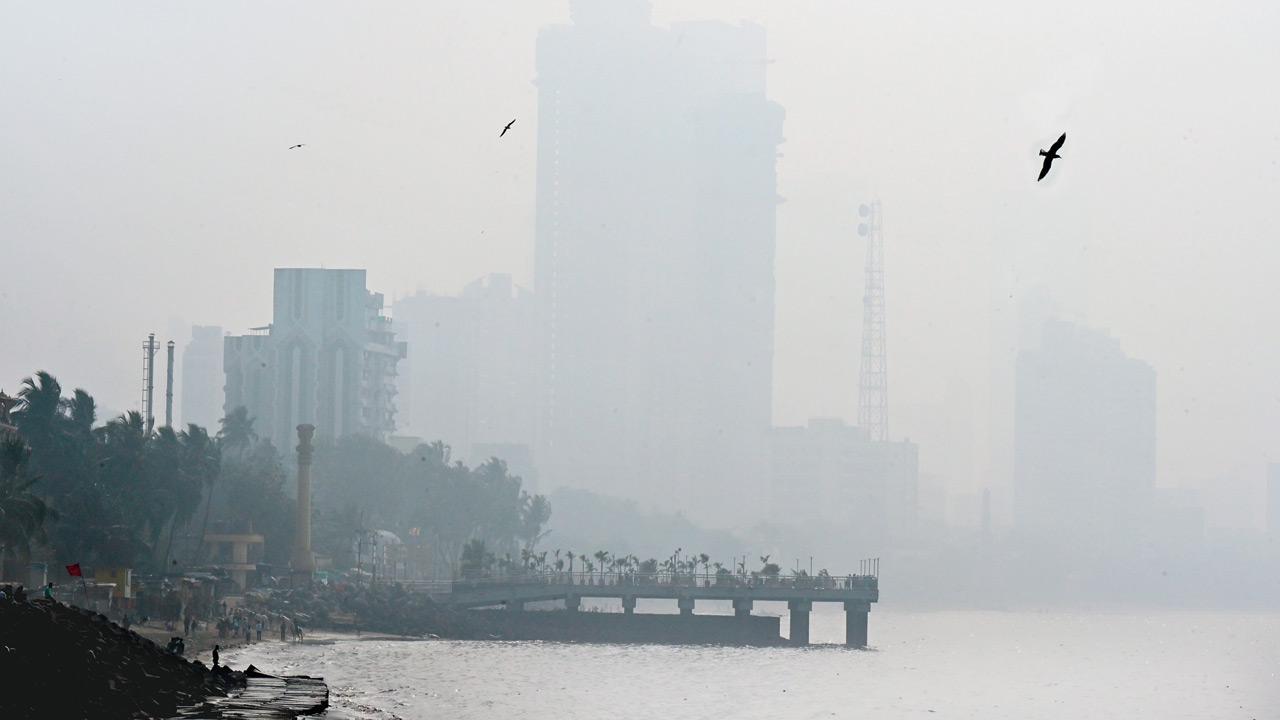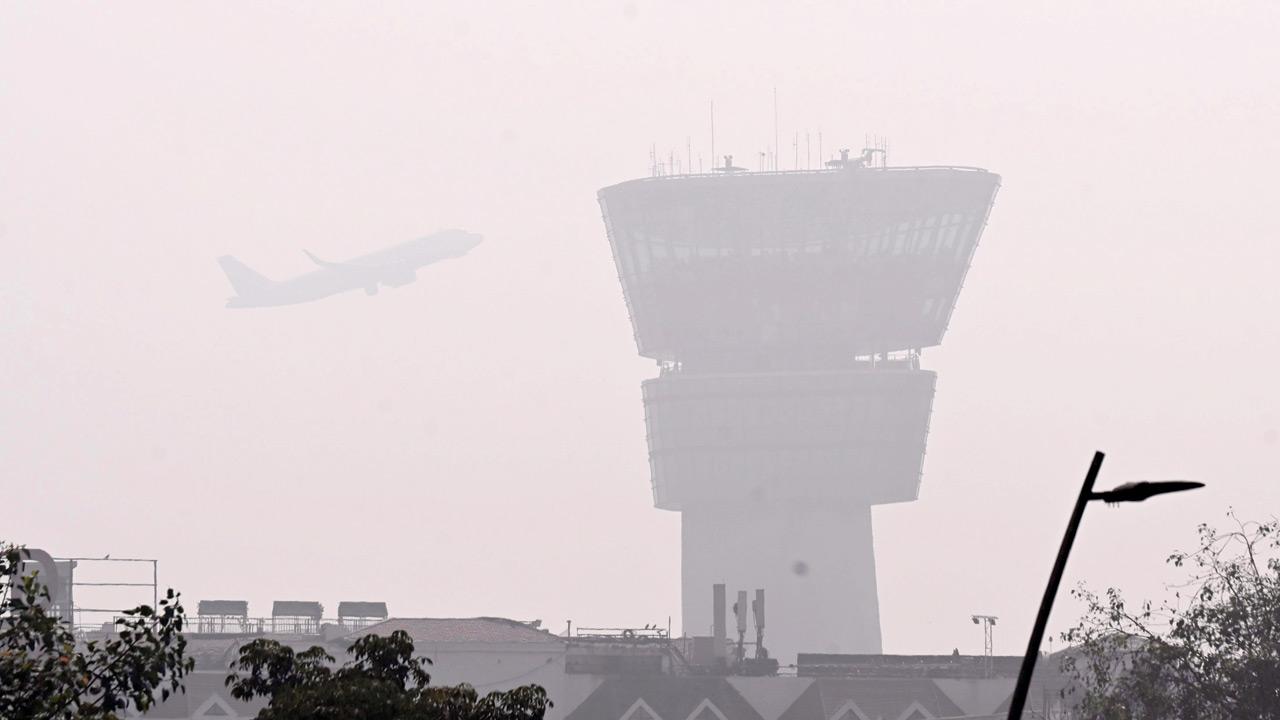City psychiatrists worried that prolonged exposure to high pollution levels is contributing to a silent mental health crisis, saying they are seeing a spike in cases where pollution levels could be the reason behind a patient’s deteriorating condition. Pollution isn’t limited to air. Noise pollution is also wreaking havoc on mental health

A dense layer of smog engulfs the Dadar viewing deck because of poor air quality in Mumbai on January 15, 2025. Pic/Shadab Khan
Mumbai’s air is turning toxic, and it’s not just the lungs that are suffering. A concerning trend has emerged—air pollution is now impacting the city’s mental health, triggering anxiety, depression, and other psychological disorders. A recent analysis of the city’s AQI data by the Waatavaran Foundation highlights a sharp decline in air quality.
ADVERTISEMENT
A recent analysis of the city's AQI data by the Waatavaran Foundation highlights a sharp decline in air quality. “From 2024 till January 2025, Mumbai witnessed only 49 days of good air quality, a drastic drop from 125 days in the same period for the previous year. Meanwhile, moderate air quality days increased to 314 in 2025 from 227 in 2024,” said Bhagwan Kesbhat, founder of the Waatavaran Foundation.
Fewer clean-air days
This worsening air quality isn’t just a respiratory concern—medical experts warn of a silent but serious mental health crisis. While there isn’t conclusive research linking pollution directly to mental instability, psychiatrists have noticed a rise in such cases.
“It’s difficult to diagnose these patients because there are no direct symptoms linking pollution to mental health. For example, if someone is experiencing personal distress, their depression or anxiety is evident.

Despite soaring temperatures, a haze blankets the air traffic control (ATC) tower at Mumbai airport, Vile Parle, on January 15. Pic/Ashish Raje
Pollution, on the other hand, isn’t a virus with a one-to-one cause-and-effect relationship. The impact is complex,” explained Dr Dinakaran D, assistant professor of psychiatry at the National Institute of Mental Health and Neurosciences (NIMHANS), Bengaluru.
Medical experts state that a decade ago, pollution wasn’t even considered a factor in mental health cases. However, today, they estimate that pollution accounts for about 10 per cent of poor mental health cases, with lifestyle and other personal factors making up the remaining 90 per cent.
“Patients don’t walk into clinics saying that pollution is causing them stress or anxiety. But when we probe deeper, the connection becomes evident. Nearly 73 per cent of studies indicate a rise in mental health symptoms due to pollution, while 6-7 per cent report worsening symptoms in those with pre-existing conditions,” said Dr Rashmi Joshi, consulting psychiatrist.
The numbers back these observations. Dr Sagar Mundada, a psychiatrist and de-addiction specialist, noted a surge in pollution-related mental health cases. “A few years ago, I encountered such cases once or twice a quarter. Now, I handle nearly 50 every quarter,” he said.
How is city suffering?
Experts cite vehicular emissions and rampant construction as the primary culprits. “In the last decade, nitrogen oxide and sulphur emissions have surged due to increased vehicular activity and relentless construction. Pollution levels, which should ideally be below 60 (as per CPCB guidelines), have shot beyond 240 and even touched 420 in some months of 2020,” explained Kesbhat.
Real-life struggles
>> Raji (29, name changed), a PR manager from Assam, developed a dust allergy that worsened into severe asthma after moving to Mumbai in 2022. “It drastically affected my mental health. I am still undergoing therapy and medication for both asthma and anxiety.”
>> Sarthak (name changed), a Mumbai-born bank employee, began experiencing fatigue, disturbed sleep, and restlessness. After multiple tests, he was diagnosed with agitated depression and has been undergoing treatment for three years.
>> Keshav (name changed), a sales head at a private firm, never smoked in his life but developed asthma two years after working in Mumbai. “My doctor initially prescribed an asthma pump once a night, which later increased to twice a day. It devastated me and brought immense stress, leading to counselling.”
How it impacts the brain
The human brain, with its delicate balance of neurotransmitters like serotonin and dopamine, is highly sensitive to environmental changes, explained Dr Joshi. “When pollution levels rise, the hypothalamic-pituitary-adrenal (HPA) axis, which regulates stress, gets triggered. Sleep disturbances caused by air pollution disrupt neurotransmitters, leading to anxiety and depression.”
Dr Mundada further explained how prolonged exposure to particulate matter (PM2.5 and PM10) bypasses the body's natural filters and enters the brain via the bloodstream. “When oxygen levels drop due to poor air quality, the amygdala—the brain’s emotional processing centre—enters panic mode, triggering a ‘fight or flight’ response, pushing individuals into cycles of overthinking, anxiety, and depression,” he said.
Indoor air pollution is just as dangerous. “Poor ventilation, dust, incense sticks, and chemical-based mosquito repellents can contribute to cognitive issues in both children and adults,” said Dr Dinakaran.
Invisible danger
Dr Lalit Anande, former medical superintendent at Sewri TB Hospital, recalled a striking case from 2019-20. “A patient with no history of smoking had lungs that appeared completely black in X-rays. It turned out he commuted 46 km daily for work, exposing him to relentless vehicular pollution,” he said.
Mumbai’s air quality index (AQI) has worsened alarmingly, rising from 135 in 2003-05 (mild effects for sensitive groups) to a staggering 420 in October 2020, posing serious health risks for all.
A vicious cycle
Pollution-induced stress is also driving lifestyle diseases like diabetes and hypertension. A 2022 Lancet report estimated that India accounts for 212 million of the world’s 828 million diabetes cases, with stress emerging as a major contributor. “We’re seeing teenagers being diagnosed with diabetes despite no family history. While lifestyle is a key factor, pollution-induced stress cannot be ignored,” said Dr Dinakaran.
Neurological disorders are also on the rise. “Cases of Alzheimer’s and dementia are more common in cities than in rural areas. Pollutants travel from the lungs to the bloodstream and even to the brain, where they cause degeneration of brain cells,” said a senior psychiatrist. Some patients, he observed, show improvement when they leave polluted cities for their hometowns.
According to the World Health Organization (WHO), 99 per cent of the global population breathes air that exceeds safe limits, with developing nations like India suffering the most. “MMR residents breathe polluted air for nearly 17 hours a day,” said Kesbhat. Speaking to mid-day, Dr Mohan Joshi, dean of Lokmanya Tilak Municipal Medical College and General Hospital (Sion), noted, “In the past year, we’ve seen a significant rise in respiratory patients who also show signs of depression and anxiety.”
Noise pollution – The other silent killer
Pollution isn’t limited to air. Noise pollution is also wreaking havoc on mental health. Dipesh (31, name changed), who works from home, developed depression due to excessive noise. “Constant honking and metro construction made it difficult to concentrate. I didn’t understand why I was becoming irritable and unproductive until a psychiatrist diagnosed me with early-stage depression caused by noise pollution,” he said.
How to tackle mental health issues amid rising pollution levels
Tips for reducing stress and anxiety outdoors (Dr Rashmi Joshi):
>> Walk instead of driving where possible
>> Limit vehicle use
>> Follow “Horn Not OK” strategies
>> Restrict indoor and outdoor fuel usage
>> Avoid morning walks during peak pollution; opt for evening or indoor workouts
Tips for minimising indoor pollution exposure (Dr Dinakaran):
>> Avoid excessive incense sticks and chemical-based mosquito repellents
>> Use natural air purifiers
>> Minimise use of room fresheners
>> Ensure proper ventilation to prevent bacterial buildup
 Subscribe today by clicking the link and stay updated with the latest news!" Click here!
Subscribe today by clicking the link and stay updated with the latest news!" Click here!







